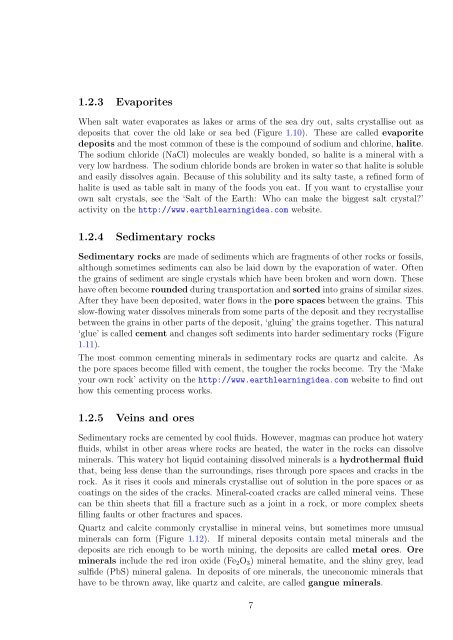The planet we live on: The beginnings of the Earth Sciences
The planet we live on: The beginnings of the Earth Sciences
The planet we live on: The beginnings of the Earth Sciences
- No tags were found...
You also want an ePaper? Increase the reach of your titles
YUMPU automatically turns print PDFs into web optimized ePapers that Google loves.
1.2.3 EvaporitesWhen salt water evaporates as lakes or arms <strong>of</strong> <strong>the</strong> sea dry out, salts crystallise out asdeposits that cover <strong>the</strong> old lake or sea bed (Figure 1.10). <str<strong>on</strong>g>The</str<strong>on</strong>g>se are called evaporitedeposits and <strong>the</strong> most comm<strong>on</strong> <strong>of</strong> <strong>the</strong>se is <strong>the</strong> compound <strong>of</strong> sodium and chlorine, halite.<str<strong>on</strong>g>The</str<strong>on</strong>g> sodium chloride (NaCl) molecules are <str<strong>on</strong>g>we</str<strong>on</strong>g>akly b<strong>on</strong>ded, so halite is a mineral with avery low hardness. <str<strong>on</strong>g>The</str<strong>on</strong>g> sodium chloride b<strong>on</strong>ds are broken in water so that halite is solubleand easily dissolves again. Because <strong>of</strong> this solubility and its salty taste, a refined form <strong>of</strong>halite is used as table salt in many <strong>of</strong> <strong>the</strong> foods you eat. If you want to crystallise yourown salt crystals, see <strong>the</strong> ‘Salt <strong>of</strong> <strong>the</strong> <strong>Earth</strong>: Who can make <strong>the</strong> biggest salt crystal?’activity <strong>on</strong> <strong>the</strong> http://www.earthlearningidea.com <str<strong>on</strong>g>we</str<strong>on</strong>g>bsite.1.2.4 Sedimentary rocksSedimentary rocks are made <strong>of</strong> sediments which are fragments <strong>of</strong> o<strong>the</strong>r rocks or fossils,although sometimes sediments can also be laid down by <strong>the</strong> evaporati<strong>on</strong> <strong>of</strong> water. Often<strong>the</strong> grains <strong>of</strong> sediment are single crystals which have been broken and worn down. <str<strong>on</strong>g>The</str<strong>on</strong>g>sehave <strong>of</strong>ten become rounded during transportati<strong>on</strong> and sorted into grains <strong>of</strong> similar sizes.After <strong>the</strong>y have been deposited, water flows in <strong>the</strong> pore spaces bet<str<strong>on</strong>g>we</str<strong>on</strong>g>en <strong>the</strong> grains. Thisslow-flowing water dissolves minerals from some parts <strong>of</strong> <strong>the</strong> deposit and <strong>the</strong>y recrystallisebet<str<strong>on</strong>g>we</str<strong>on</strong>g>en <strong>the</strong> grains in o<strong>the</strong>r parts <strong>of</strong> <strong>the</strong> deposit, ‘gluing’ <strong>the</strong> grains toge<strong>the</strong>r. This natural‘glue’ is called cement and changes s<strong>of</strong>t sediments into harder sedimentary rocks (Figure1.11).<str<strong>on</strong>g>The</str<strong>on</strong>g> most comm<strong>on</strong> cementing minerals in sedimentary rocks are quartz and calcite. As<strong>the</strong> pore spaces become filled with cement, <strong>the</strong> tougher <strong>the</strong> rocks become. Try <strong>the</strong> ‘Makeyour own rock’ activity <strong>on</strong> <strong>the</strong> http://www.earthlearningidea.com <str<strong>on</strong>g>we</str<strong>on</strong>g>bsite to find outhow this cementing process works.1.2.5 Veins and oresSedimentary rocks are cemented by cool fluids. Ho<str<strong>on</strong>g>we</str<strong>on</strong>g>ver, magmas can produce hot wateryfluids, whilst in o<strong>the</strong>r areas where rocks are heated, <strong>the</strong> water in <strong>the</strong> rocks can dissolveminerals. This watery hot liquid c<strong>on</strong>taining dissolved minerals is a hydro<strong>the</strong>rmal fluidthat, being less dense than <strong>the</strong> surroundings, rises through pore spaces and cracks in <strong>the</strong>rock. As it rises it cools and minerals crystallise out <strong>of</strong> soluti<strong>on</strong> in <strong>the</strong> pore spaces or ascoatings <strong>on</strong> <strong>the</strong> sides <strong>of</strong> <strong>the</strong> cracks. Mineral-coated cracks are called mineral veins. <str<strong>on</strong>g>The</str<strong>on</strong>g>secan be thin sheets that fill a fracture such as a joint in a rock, or more complex sheetsfilling faults or o<strong>the</strong>r fractures and spaces.Quartz and calcite comm<strong>on</strong>ly crystallise in mineral veins, but sometimes more unusualminerals can form (Figure 1.12). If mineral deposits c<strong>on</strong>tain metal minerals and <strong>the</strong>deposits are rich enough to be worth mining, <strong>the</strong> deposits are called metal ores. Oreminerals include <strong>the</strong> red ir<strong>on</strong> oxide (Fe 2 O 3 ) mineral hematite, and <strong>the</strong> shiny grey, leadsulfide (PbS) mineral galena. In deposits <strong>of</strong> ore minerals, <strong>the</strong> unec<strong>on</strong>omic minerals thathave to be thrown away, like quartz and calcite, are called gangue minerals.7
















